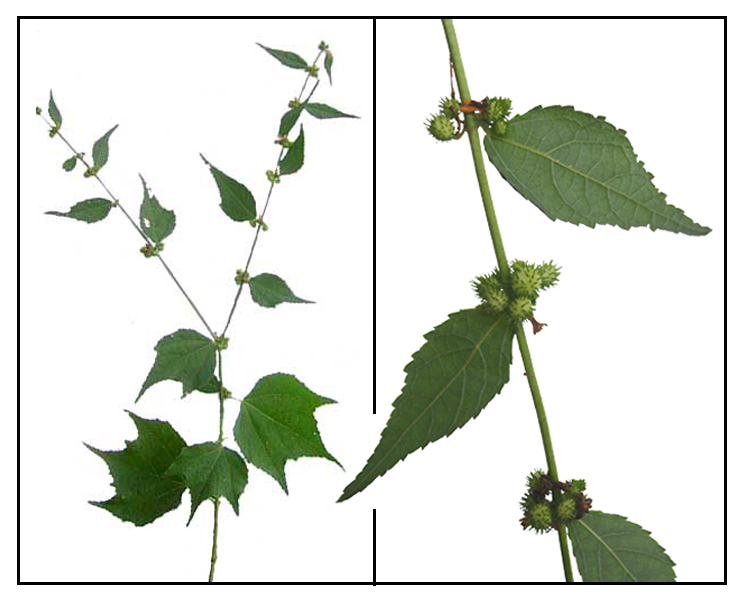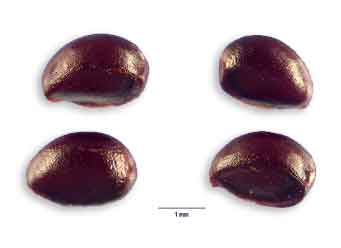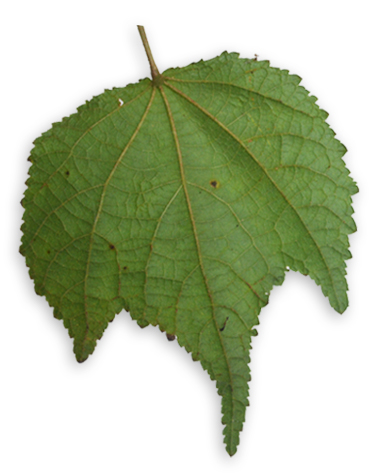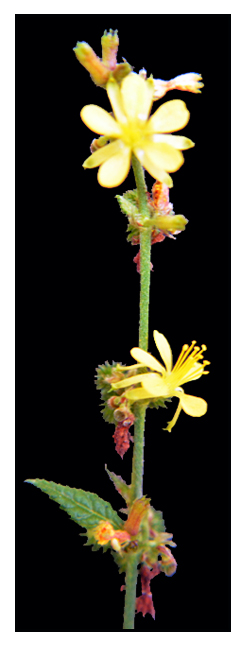 General info General info
- Triumfetta is a genus of plants in the family Malvaceae. There are about 176 species in the genus, which are widespread across tropical regions.
- The genus was originally described by Carl Linnaeus in 1753.
- Triumfetta rhomboidea is a shrub extensively naturalized in tropical regions. The taxon was first formally described by botanist Nikolaus von Jacquin in 1760.
Botany
• Kulutkulutan erect, more or less hairy,
branched annual, often half-woody shrub, growing to a height
of 0.5 to 1.5 meters. Leaves are variable, usually orbicular to rhomboid-ovate,
2 to 6 centimeters in length, entire or 3-lobed, the upper ones oblong
to ovate-lanceolate, smaller and not lobed. Flowers are yellow,
numerous, about 6 millimeters long, borne on dense axillary fascicles.
Fruit is small, rounded, hairy, covered with hooked, smooth spines.
 • Subshrubs or herbs. Branchlets gray-brown tomentose. Petiole 1-5 cm; lower leaf blades broadly ovate-orbicular, rhomboid, or broadly ovate, 3-lobed, 3-9.5 × 2-8.5 cm, abaxially stellate pilose, adaxially sparsely hairy, basal veins 3-5, 2 lateral ones reaching tip of lobes, base broadly cuneate or rounded, margin irregularly bluntly serrate, apex acute; upper leaf blades oblong-lanceolate, not lobed. Cymes 3-5 per axil; peduncle to 2 mm. Flower buds cylindrical, apex slightly wider, ca. 4 mm. Pedicel less than 1 mm. Sepals narrowly oblong, 4.5-5.5 mm, villous, appendaged at tip. Petals yellow, slightly shorter than sepals, hairy along margins. Stamens 10. Ovary spiny. Capsule globose, ca. 3 mm in diam., spiny, indehiscent; spines ca. 2 mm, gray-yellow puberulent, tip hooked. Seeds 2-6. (Flora of China) • Subshrubs or herbs. Branchlets gray-brown tomentose. Petiole 1-5 cm; lower leaf blades broadly ovate-orbicular, rhomboid, or broadly ovate, 3-lobed, 3-9.5 × 2-8.5 cm, abaxially stellate pilose, adaxially sparsely hairy, basal veins 3-5, 2 lateral ones reaching tip of lobes, base broadly cuneate or rounded, margin irregularly bluntly serrate, apex acute; upper leaf blades oblong-lanceolate, not lobed. Cymes 3-5 per axil; peduncle to 2 mm. Flower buds cylindrical, apex slightly wider, ca. 4 mm. Pedicel less than 1 mm. Sepals narrowly oblong, 4.5-5.5 mm, villous, appendaged at tip. Petals yellow, slightly shorter than sepals, hairy along margins. Stamens 10. Ovary spiny. Capsule globose, ca. 3 mm in diam., spiny, indehiscent; spines ca. 2 mm, gray-yellow puberulent, tip hooked. Seeds 2-6. (Flora of China)
Distribution
- Native to the Philippines.
-
Very common in open
waste places in all islands and provinces, at low and medium altitudes.
- Also native to Andaman Is., Angola, Assam, Bangladesh, Benin, Botswana, Burkina, Burundi, Cambodia, Cameroon, Cape Provinces, Cape Verde, Central African Republic, China South-Central, China Southeast, Congo, East Himalaya, Eritrea, Ethiopia, Gabon, Gambia, Ghana, Guinea, Guinea-Bissau, Gulf of Guinea Is., India, Ivory Coast, Kazan-retto, Kenya, KwaZulu-Natal, Laos, Lesser Sunda Is., Liberia, Malawi, Malaya, Mali, Mozambique, Myanmar, Namibia, Nansei-shoto, Nepal, Nicobar Is., Nigeria, Northern Provinces, Pakistan, Queensland, Rwanda, Saudi Arabia, Senegal, Sierra Leone, Solomon Is., South China Sea, Sri Lanka, Sudan, Swaziland, Taiwan, Tanzania, Thailand, Togo, Uganda, Vietnam, West Himalaya, Yemen, Zambia, Zaïre, Zimbabwe. (14)
 Constituents Constituents
- Study of aerial parts for essential oil yielded main constituents of trans-ß-caryophyllene (22.4%), kessane (14%), and caryophyllene oxide (13%). (see study below) (2)
-
Plant yields carbohydrate glycosides, phytosterols, steroids, flavonoids, tannin, phenolic compounds and triterpenoids. (6)
- Study yielded yielded ß-sitosterol, friedelin, friedelinol quercetin, 2,6-dimethoxy-1,4-benzoquinone
and rosmarinic acid. (4)
- Ethanol extract of leaves yielded carbohydrates, glycosides, tannins, flavonoids, steroids, saponins, and terpenoids. (see study below)
(17)
- Phytochemical screening of petroleum ether extract and methanol extract of dried leaves yielded carbohydrates (M), glycosides (M,Pe), phytosterols and steroids (M, Pe), flavonoids (M, Pe), protein and amino acid (M), and triterpenoids (M, Pe), with absence of alkaloids, tannins, resins, and gum of mucilage.
(see study below) (18)
- Proximate analysis of composition of pulverized leaves revealed 11.01% moisture content, 3.38% ash content, 15.15% crude fiber, 7.34% crude fat, 61.09% carbohydrate content, 17.18% protein content, and 379.14 kJ energy value. Total phenol content in aqueous and ethanol extracts were 20.36 and 12.66 mg GAE/g, respectively. Total flavonoid was 18.18 and 22.77 mg QE/g, and antioxidant capacity of 16.34 and 48.16 mg AAE/100 g for aqueous and ethanol extracts, respectively. (see study below) (26)
- Study of twigs isolated a new ceramide (1), along with lupeol (2) and a mixture of ß-sitosterol and stigmasterol, oleanolic acid (4), maslinic acid (5), ß-sitosterol glucopyranoside (6), and trans-tiliroside (7). (see study below) (31)
Properties
- Roots, bark,
leaves are mucilaginous and in decoction are astringent.
- Root considered styptic, aphrodisiac, galactagogue, diuretic, cooling.
- Studies have suggested antitumor, antioxidant, antimicrobial, hepatoprotective, antidiabetic, diuretic, anticancer, lactogenic, COX-1 inhibitory, anti-inflammatory, immune-modulating, sperm and hormone-modulating, anthelmintic properties.
Parts
used
Roots, leaves, bark, flowers.
 Uses Uses
Edibility
- Leaves are edible with a tomato-like taste; occasionally used in soups. (15)
- Stem and green back are sources of mucilage, used for making slimy soups and sauces. Because of high protein value, given to women after childbirth. (15)
- Used as famine food. (15)
Folkloric
- Pounded or decoction of roots used for intestinal
ulcers.
- Decoction of roots and leaves used in decoction as emollient. Also employed as antiblennorrhagic.
- Zulu women use a hot infusion of roots used to facilitate childbirth or hasten inception of parturition.
- Bark and fresh leaves used in diarrhea.
- Decoction of root and bark in rice water used for treatment of diarrhea, dysentery, internal hemorrhages, and gonorrhea. (24)
- Roots, bark, and leaves are mucilaginous; considered astringent in infusion or decoction.
- Pounded roots given for intestinal ulcers.
- Leaves, flowers, and roots used in gonorrhea and leprosy.
- In Rwanda, used
as abortifacient and for snake bites.
- In Kenya root infusion applied to site of snake bites. In Tanzania powdered leaves are tied to the affected site and decoction taken orally once a day. (13)
- In Nepal, leaves
used for boils. Plant paste used for boils, pimples, and blisters.
- In East Africa, powdered leaves used for treatment of anemia. (24)
- In Assam, tribals of Kaziranga National Park use use stems and leaves to treat stomachache, indigestion, and fever during menstruation. (33)
- In Andhra Pradesh, the Bagata tribe massage crushed leaves on affected areas of rheumatoid arthritis to reduce swellings and pain. (34)
Others
- Fiber: Bark—sometimes called burbark—yields a soft, glossy fiber, somewhat similar to jute. (15)
Studies
• Antitumor / Antioxidant: Study evaluated a methanol extract of TR for antitumor and antioxidant activities against Dalton's ascites lymphoma bearing Swiss albino mice. Results showed significant antitumor and antioxidant
activity in vivo. (1)
• Antimicrobial / Essential Oil / Aerial Parts: Antimicrobial tests showed mild activity
against E coli and Enterococcus hirae. The main constituents were trans-B-caryophyllene,
kessane and caryophyllene oxide. (2)
• Immune Modulating: Triumfetta rhomboidea was one of the Rwandan
medicinal plants studied for complement modulating activity. (3)
• Phytochemicals: Study
yielded ß-sitosterol, friedelin, friedelinol quercetin, 2,6-dimethoxy-1,4-benzoquinone
and rosmarinic acid. (4)
• Antibacterial: Study
yielded carbohydrate glycosides, phytosterols, steroids, flavonoids, tannin, phenolic compounds and triterpenoids. Results showed TR exhibited good antibacterial action. (6)
• Hepatoprotective: Study evaluated the hepatoprotective activity of ethanolic extract of T. bartramia and I. glandulifera with Silymarin as standard drug. Results showed significant hepatoprotective activity with good regenerative areas and reduction of liver necrosis. (9)
• Antidiabetic: Study evaluated the antidiabetic effect of ethanolic extract of R. rhomboidea in alloxan induced diabetic rats. Results showed significant dose dependent decrease in blood glucose levels, comparable to glibenclamide. (10)
• Diuretic / Roots / Leaves: Study evaluated the diuretic activity of alcohol and aqueous extracts of roots in Wistar albino rats. Both extracts showed significant dose dependent diuretic activity with significant increase in urinary output and urine concentrations of urine Na+ and K+. (11) Study evaluated methanol and petroleum ether extracts of dried leaves for diuretic activity. Results showed dose dependent diuretic effect. The highest dose of the methanol extract showed maximum diuretic activity. (see constituents above) (18)
• Anti-Inflammatory: Study of 70% methanolic extract of Triumfetta rhomboidea showed anti-inflammatory activity as evidenced by protein denaturation activity and membrane stabilizing effect on human red blood cells. (16)
• Cytotoxicity against Cancer Cell Lines (HT-29 and HeLa) / Leaves: Study evaluated an ethanol extract of leaves for cytotoxic activity against various cancer cell lines i.e., HT-29 (human colorectal cancer cell line), HeLa (human epithelial cervical cancer) and C2C12 (mouth muscle cell line) by MTT assay. The extract exhibited moderate cytotoxic activity towards HT-29 and HeLa cancer cell lines. (see constituents above) (17)
• Analgesic / Anti-Inflammatory / Leaves: Study evaluated the analgesic and anti-inflammatory effects of methanolic extract of leaves of T. rhomboidea on mice and rats, respectively using acetic acid-induced writhing in mice and egg albumin-induced rat paw edema. Results showed statistically significant dose-dependent (p<0.001) inhibition of egg albumin induced edema or inflammation in Wister albino rats, an effect higher than standard Piroxicam. The extract also caused statistically significant )p<0.001) reduction of acetic acid induced writhing in mice. Phytochemical screening of the leaf extract yielded flavonoids, steroids, triterpenoids, alkaloids, tannins and saponins. (19)
• Lactogenic / Root: Study evaluated the lactogenic activity of aqueous extract of T. rhomboidea roots on nursing rats. Results showed oral administration of aqueous extract of roots increased the milk yield, body weight of pups as well as mother rat, glycogen and protein content of mammary gland tissue, serum prolactin and cortisol levels. (20)
• COX-1 Inhibitory Effect: Study evaluated ethanol extracts of 17 species for inhibitory effect in a COX-1 assay. The extracts of Triumfetta rhomboidea, Gardenia ternifolia, Thonningia sanguinea, and root of Zanthoxylum xanthoxyloides showed inhibitory effect over 90% in the final concentration of 0.1 µg/mL. (21)
• Effect on Hormonal and Male Fertility Function / Leaves: Study evaluated the effect of aqueous extracts of TR leaves on hormonal and male fertility in male guinea pigs. Results showed aqueous extract of TR significantly (p<0.05) increased the basal level of serum testosterone with little or no effect on serum levels of LH, FSH, and prolactin of male guinea pig. Extract at dose of 400 mg/kg significantly (p<0.05) increased the sperm count from 61.25 to 81.75 (14 days) and 98.75 (28 days). Over different time exposures, the extract caused mild, moderate to severely diffused and generalized macrovesicular steatosis in a time-dependent alterations of various organs histology compared to controls. Results suggest the aqueous extract may be useful in treating fertility problems associated with oligospermia (low sperm count) and low testosterone level. (25)
• Proximate Composition / Antioxidant Potential / Leaves: Study evaluated the proximate composition of pulverized leaves and TPC, TFC, TAC, FRAP, RP and lipid peroxidation inhibition. Results showed T. rhomboidea leaves possess biologically active constituents and potential for free radical scavenging activities in reactive oxygen species related diseases. (see constituents above) (26)
• Anticancer / Molecular Docking Approach: HR-LCMS analysis of Tiumfetta rhomboidea identified 15 metabolites. MTT analysis of Triumfetta rhomboidea for cytotoxic potential confirmed both n-hexane and ethyl acetate fractions possess strong anticancer activity in MCF-7 cell lines. Docking of phytochemicals to determine ligands binding affinities to epidermal growth factor receptor (EGFR) and vascular endothelial growth factor (VEGFR) receptors showed annofoline, caffeine, procyanidin b6, luteolin, robinetinidol, 8-hydroxy-1-methoxy-3-methyl-anthraquinone, myricetin, and jaceidin possess increased binding energies and affinities for target receptors. The suppression of EGFR and VEGFR suggest possibility for use in anticancer medications. Results suggest T. rhomboidea has undeniable medical significance. (27)
• Antitubercular / Anthelmintic: Study evaluated the invitro anti-tubercular and anthelmintic activity of T. rhomboidea. The antitubercular activity of compounds was assessed against Mycobacterium tuberculosis using Microplate Alamar Blue Assay (MABA) at eight concentrations from 100 to 0.2 µg/ml. Anthelmintic activity was evaluated on adult Indian earthworms, Endrullus enguinae, using concentrations of 25, 50, and 100 mg/ml. Both activities were dose-dependent, the highest concentration showing maximum activity. The anti-mycobacterial activity may be due to phenolic compounds. (24) (28)
• Acute and Sub-Chronic Toxicity Studies / Leaves: Study evaluated the safety of aqueous and ethanol extracts of T. rhomboidea leaves in normal male albino rats. Acute toxicity study revealed an LD50 above 5000 mg extract/kg for both extracts. Sub-chronic testing using doses of 100, 500, 1000, 3000, and 5000 mg extract daily by oral gavage for 28 days increased rat body weight. The doses demonstrated significant reduction in AST, ALP, GGT, creatinine, while doses above 300 mg of aqueous extract significantly (p<0.05) elevated urea. Elevation in cholesterol was associated with significant increase in HDL-C. Results suggest safety of aqueous and ethanol extracts, but caution is advised in humans because continuous dosing could alter organ structures. (29)
• Cytotoxicity / Safety Study: Study evaluated the cytotoxicity of methanolic extract of T. rhomboidea on 3T3 mice fibroblast cell line using sulforhodamine B (SRB) assays. Results revealed the plant extracts did not show any toxic effects till 1.0 mg/ml. Therefore, composition below 1 mg/ml can be subjected to medicinal preparations. (30)
• Cytotoxicity / Human Fibrosarcoma Cancer Cell Line / Twigs: Study of twigs isolated a new ceramide (1), along with lupeol (2) and a mixture of ß-sitosterol and stigmasterol, oleanolic acid (4), maslinic acid (5), ß-sitosterol glucopyranoside (6), and trans-tiliroside (7). Cytotoxic activity of crude extract, fractions, and compounds were evaluated against human fibrosarcoma cancer cell line HT1080 using flow cytometry. The ethyl acetate fraction showed weak activity while crude extract and hexane and n-butanol fractions presented less than 50% of cell growth inhibition. (31)
• Chemopreventive Effect / Leaves: Study evaluated the chemopreventive potential of T. rhomboidea leaves extracts by measures of tumor incidence, total number of tumors and tumor volume, and analysis of biochemical markers sch as 17-ß estradiol (E2), TBARS and antioxidants during DBMA induced mammary carcinoma. Oral administration of of 100 and 100 mg of TRM to DMBA treated rats significantly prevented tumor incidence, total number of tumors, tumor volume, and returned biochemical markers to normal. Results confirmed the chemopreventive activity of leaves of T. rhomboidea in mammary carcinoma. (32)
Availability
Wild-crafted.
|

![]()



 General info
General info • Subshrubs or herbs. Branchlets gray-brown tomentose. Petiole 1-5 cm; lower leaf blades broadly ovate-orbicular, rhomboid, or broadly ovate, 3-lobed, 3-9.5 × 2-8.5 cm, abaxially stellate pilose, adaxially sparsely hairy, basal veins 3-5, 2 lateral ones reaching tip of lobes, base broadly cuneate or rounded, margin irregularly bluntly serrate, apex acute; upper leaf blades oblong-lanceolate, not lobed. Cymes 3-5 per axil; peduncle to 2 mm. Flower buds cylindrical, apex slightly wider, ca. 4 mm. Pedicel less than 1 mm. Sepals narrowly oblong, 4.5-5.5 mm, villous, appendaged at tip. Petals yellow, slightly shorter than sepals, hairy along margins. Stamens 10. Ovary spiny. Capsule globose, ca. 3 mm in diam., spiny, indehiscent; spines ca. 2 mm, gray-yellow puberulent, tip hooked. Seeds 2-6. (
• Subshrubs or herbs. Branchlets gray-brown tomentose. Petiole 1-5 cm; lower leaf blades broadly ovate-orbicular, rhomboid, or broadly ovate, 3-lobed, 3-9.5 × 2-8.5 cm, abaxially stellate pilose, adaxially sparsely hairy, basal veins 3-5, 2 lateral ones reaching tip of lobes, base broadly cuneate or rounded, margin irregularly bluntly serrate, apex acute; upper leaf blades oblong-lanceolate, not lobed. Cymes 3-5 per axil; peduncle to 2 mm. Flower buds cylindrical, apex slightly wider, ca. 4 mm. Pedicel less than 1 mm. Sepals narrowly oblong, 4.5-5.5 mm, villous, appendaged at tip. Petals yellow, slightly shorter than sepals, hairy along margins. Stamens 10. Ovary spiny. Capsule globose, ca. 3 mm in diam., spiny, indehiscent; spines ca. 2 mm, gray-yellow puberulent, tip hooked. Seeds 2-6. ( Constituents
Constituents Uses
Uses